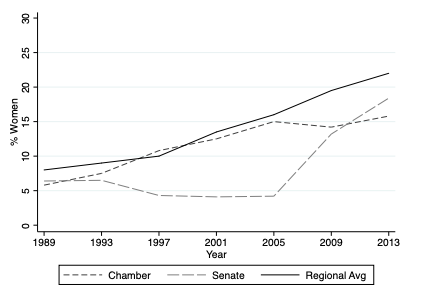Chile’s Gender Quota: Will It Work?

Table of Contents
To access the full paper, download the PDF on the left-hand sidebar.
Introduction
On January 20, 2015, Chile’s Congress approved the final version of a bill significantly reforming the national electoral system. After years of discussion about electoral reform and nine months of congressional debate about this specific bill, the Chilean Chamber of Deputies and Senate passed the reform package with support from three-fifths of the members of both houses of Congress and the endorsement of the bill’s initiator, Chile’s President Michelle Bachelet.1 At the end of March 2015, Chile’s constitutional court rejected claims of unconstitutionality put forth by 12 dissenting senators, clearing the way for President Bachelet to sign the bill into law on April 27.
The new law is significant for many reasons. First, it finally eliminates the highly unrepresentative and unique-to-Chile binomial electoral system designed by former dictator Augusto Pinochet in 1989. Under the binomial system, every electoral district for both houses of Congress had two seats. On Election Day, the party that won the most votes in the district won one of those seats and the runner-up party won the second seat, unless the winning party doubled the vote share of the second-place party. This system resulted in significantly disproportional election outcomes and ensured continued political power for the conservative right long after the transition to democracy occurred. The new electoral reform replaces the binomial system with an open list proportional representation (PR) system with between two and eight seats in every electoral district. Under proportional representation, parties are awarded seats in direct proportion to the percentage of votes they win (40 percent of the vote translates to approximately 40 percent of the seats in the district), and the “open list” means that voters choose not only their preferred party but also their preferred candidates on the party ballot (parties can have as many candidates on the ballot as there are seats in the district plus one). This reform has been widely praised because it is expected to yield a much more representative, competitive, and democratic election process.2
The second important piece of the Chilean electoral reform, and the dimension of primary interest for this issue brief, is a provision that requires all political parties competing in congressional elections to ensure that no more than 60 percent of candidates on the ballot in every district are of the same sex. Implicitly, this is a requirement that at least 40 percent of candidates on party ballots are women. With this new electoral reform, Chile has implemented a gender quota.
Electoral reformers in Chile have worked for over 20 years to replace the binomial system, and quota advocates have worked almost as long to enact a gender quota that would help to improve women’s underrepresentation in the national Congress. In the first post-transition congressional election in 1989, women won seven of 120 seats (5.8 percent) in the Chamber of Deputies and three of 38 seats (6.4 percent) in the Senate. Twenty-four years later in 2013, women’s representation had only increased to 15.8 percent in the Chamber of Deputies and 18.4 percent in the Senate, and the country has continued to lag behind the Latin American regional average (see Figure 1). Despite changing cultural attitudes toward women in the public sphere, women’s significant entry into the formal labor force, and the near-parity numbers in institutions of higher education, women have not gained entry to Congress to the same degree. Chile’s congressional representation of women today is one of the worst in the region. After a quarter century of relatively minimal progress moving women into the legislative arena in Chile, proponents of the new gender quota law hope that the quota will finally achieve what more traditional efforts to increase women’s representation have failed to do. Will it work?
Figure 1 — Women’s Representation in the Chilean Congress

This material may be quoted or reproduced without prior permission, provided appropriate credit is given to the author and Rice University’s Baker Institute for Public Policy. The views expressed herein are those of the individual author(s), and do not necessarily represent the views of Rice University’s Baker Institute for Public Policy.